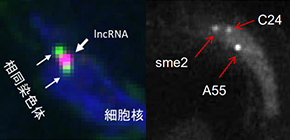
Mechanism of pairing of homologous chromosomes clarified
Will unravel causes of Down Syndrome and miscarriages attributable to chromosome segregation errors
A group of researchers from the National Institute of Information and Communications Technology (NICT) and Osaka University discovered a mechanism of pairing of homologous chromosomes in the fission yeast Schizosaccharomyces pombe .
The paring involved in “recombination of genetic information” during meiosis is important for ensuring accurate chromosome segregation for all life. Meiosis, a special type of cell division in sexually-reproducing organisms, occurs in all eukaryotes, including humans. During meiosis, genetic recombination takes place via pairing of homologous chromosomes from parents; however, how homologous chromosomes find their homologous partners was not known.
This group has previously demonstrated that the fission yeast sme2 RNA, a meiosis-specific long non-coding RNA (lncRNA), accumulates at the sme2 chromosomal loci and mediates their robust pairing in meiosis. In this study, using fluorescent imaging, they found two locations that show a high pairing frequency of homologous chromosomes: the A55 locus on chromosome I and the C24 locus on chromosome III.
They also found that liquid-liquid phase separation (LLPS), which is caused by complexes consisting of lncRNAs transcribed from chromosomal loci and transcription termination factors (Smp proteins), played an important role in robust pairing of homologous chromosomes.
In addition, they found that during meiosis, the omt3 RNA and lncRNA584 also formed a single RNA dot at each of their respective gene loci, A55 locus and C24 locus. They searched proteins in these locations from their Green Fluorescent Protein (GFP) library of the fission yeast, finding that 10 Smp proteins were involved in transcription termination. All 10 of these Smp proteins are RNA-binding proteins.
Six of these 10 Smp proteins were identified as proteins required for robust pairing of homologous chromosomes. These six Smp proteins, together with lncRNA, formed liquid droplets (Smp/lncRNA droplets) that cause LLPS. Only liquid droplets bearing the same RNA species fused, promoting the recognition of homologous loci and subsequent paring of homologous chromosomes.
This study clarified part of a mechanism behind paring of homologous chromosomes, an important process for living organisms to produce offspring. They demonstrated the roles of lncRNA–protein complexes assembled at specific chromosomal loci to tether homologous chromosomes. That is, lncRNA determines specificity for pairing of homologous loci and lncRNA–protein complexes assembled at specific chromosomal loci mediate recognition of homologous chromosomes.
Further examination will lead to the elucidation of the formation mechanism of human sperms and eggs. That the pairing of homologous chromosomes can be explained by a physical phenomenon of LLPS suggests that this mechanism may be common to every living organism. This group’s achievements are a great step toward the clarification of the mechanisms of genetic transmission and will elucidate causes of Down Syndrome and miscarriages attributable to chromosome missegregation during meiosis.

Figure 1

Figure 2

Figure 3

Figure 4

Figure 5

Figure 6
The article, “Chromosome-associated RNA–protein complexes promote pairing of homologous chromosomes during meiosis in Schizosaccharomyces pombe,” was published in Nature Communications at DOI: https://doi.org/ 10.1038/s41467-019-13609-0 .
Related links
- Hiraoka Laboratory, Graduate School of Frontier Biosciences, Osaka University
- NICT press release (November 3, 2009) (link in Japanese)
- NICT press release (May 11, 2012) (link in Japanese)
